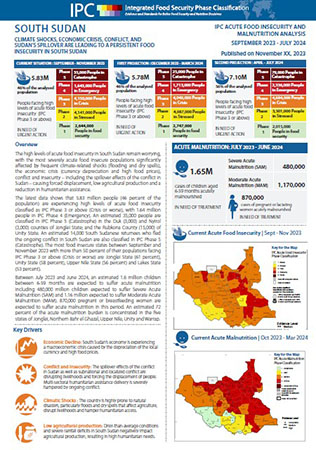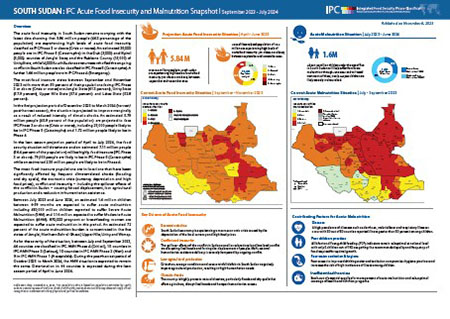
- © WFP
South Sudan: Approximately 5.83 million people likely to experience high levels of acute food insecurity, 1.65 million children expected to be acutely malnourished
The acute food insecurity in South Sudan remains worrying with the latest data showing that approximately 5.83 million people – almost half of South Sudan’s population (46 percent) – are experiencing high levels of acute food insecurity classified as IPC Phase 3 or above (Crisis or worse) between September to November 2023. An estimated 35,000 people are in IPC Phase 5 (Catastrophe) in the Duk (3,000) and Nyirol (3,000) counties of Jonglei State; and the Rubkona County (15,000) of Unity State, while 14,000 South Sudanese returnees who fled the ongoing conflict in South Sudan are also classified in IPC Phase 5 (Catastrophe). A further 1.64 million people are in IPC Phase 4 (Emergency).
In the harvest/post-harvest projection period of December 2023 to March 2024, the situation is projected to improve marginally as a result of reduced intensity of climatic shocks. An estimated 5.78 million people (46 percent of the population) are projected to face IPC Phase 3 or above (Crisis or worse), including 25,000 people likely to be in IPC Phase 5 (Catastrophe) and 1.71 million people likely to be in Phase 4. In the lean season projection period of April to July 2024, the food security situation will deteriorate and an estimated 7.10 million people (56 percent of the population) will be highly food insecure (IPC Phase 3 or above). 79,000 people are likely to be in IPC Phase 5 (Catastrophe) while an estimated 2.34 million people are likely to be in Phase 4.
The most food insecure populations are in locations that have been significantly affected by frequent climate-related shocks (flooding and dry spells), the economic crisis (currency depreciation and high food prices), conflict and insecurity – including the spillover effects of the conflict in Sudan – causing forced displacement, low agricultural production and a reduction in humanitarian assistance.
Acute malnutrition analysis findings show that approximately 1.65 million children aged 6 to 59 months are expected to suffer acutely malnourished between July 2023 and June 2024, including 480,000 children who are likely to be severely malnourished. In addition, 870,000 pregnant or breastfeeding women are expected to suffer acute malnutrition in this period. Of the 80 counties analysed, 46 are classified in IPC AMN Phase 4 (Critical).
Join our mailing list


